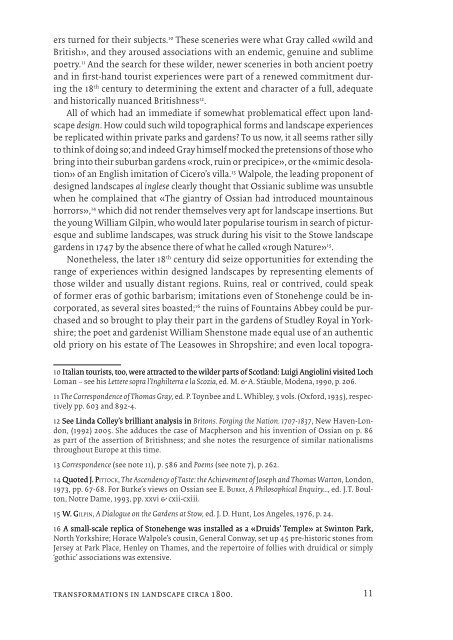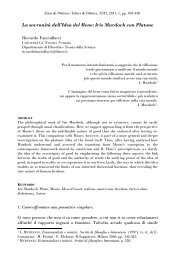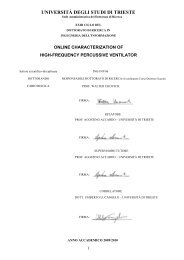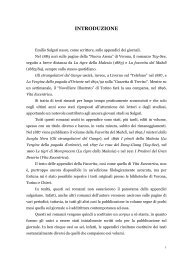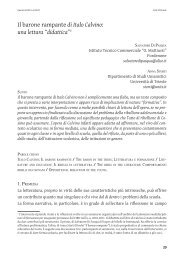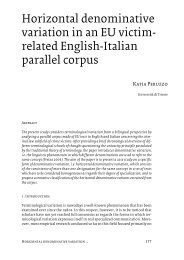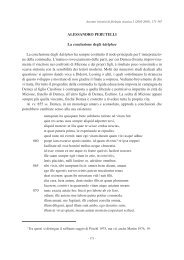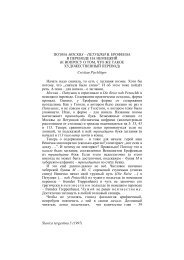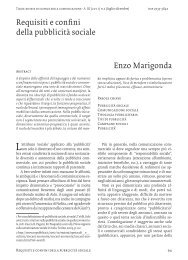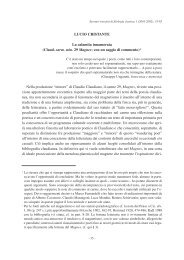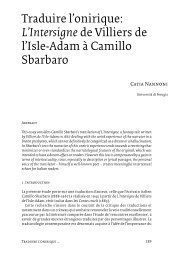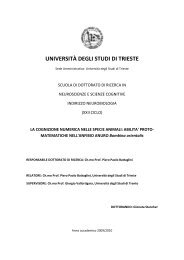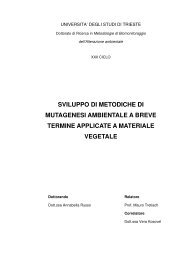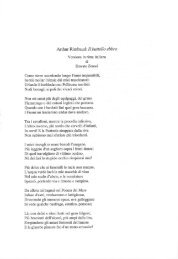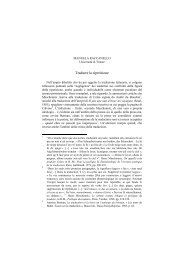Melchiorre Cesarotti e le trasformazioni del paesaggio ... - OpenstarTs
Melchiorre Cesarotti e le trasformazioni del paesaggio ... - OpenstarTs
Melchiorre Cesarotti e le trasformazioni del paesaggio ... - OpenstarTs
Create successful ePaper yourself
Turn your PDF publications into a flip-book with our unique Google optimized e-Paper software.
ers turned for their subjects. 10 These sceneries were what Gray cal<strong>le</strong>d «wild and<br />
British», and they aroused associations with an endemic, genuine and sublime<br />
poetry. 11 And the search for these wilder, newer sceneries in both ancient poetry<br />
and in first-hand tourist experiences were part of a renewed commitment during<br />
the 18 th century to determining the extent and character of a full, adequate<br />
and historically nuanced Britishness 12 .<br />
All of which had an immediate if somewhat prob<strong>le</strong>matical effect upon landscape<br />
design. How could such wild topographical forms and landscape experiences<br />
be replicated within private parks and gardens? To us now, it all seems rather silly<br />
to think of doing so; and indeed Gray himself mocked the pretensions of those who<br />
bring into their suburban gardens «rock, ruin or precipice», or the «mimic desolation»<br />
of an English imitation of Cicero’s villa. 13 Walpo<strong>le</strong>, the <strong>le</strong>ading proponent of<br />
designed landscapes al ing<strong>le</strong>se c<strong>le</strong>arly thought that Ossianic sublime was unsubt<strong>le</strong><br />
when he complained that «The giantry of Ossian had introduced mountainous<br />
horrors», 14 which did not render themselves very apt for landscape insertions. But<br />
the young William Gilpin, who would later popularise tourism in search of picturesque<br />
and sublime landscapes, was struck during his visit to the Stowe landscape<br />
gardens in 1747 by the absence there of what he cal<strong>le</strong>d «rough Nature» 15 .<br />
Nonethe<strong>le</strong>ss, the later 18 th century did seize opportunities for extending the<br />
range of experiences within designed landscapes by representing e<strong>le</strong>ments of<br />
those wilder and usually distant regions. Ruins, real or contrived, could speak<br />
of former eras of gothic barbarism; imitations even of Stonehenge could be incorporated,<br />
as several sites boasted; 16 the ruins of Fountains Abbey could be purchased<br />
and so brought to play their part in the gardens of Stud<strong>le</strong>y Royal in Yorkshire;<br />
the poet and gardenist William Shenstone made equal use of an authentic<br />
old priory on his estate of The Leasowes in Shropshire; and even local topogra-<br />
10 Italian tourists, too, were attracted to the wilder parts of Scotland: Luigi Angiolini visited Loch<br />
Loman – see his Lettere sopra l’Inghilterra e la Scozia, ed. M. & A. Stäub<strong>le</strong>, Modena, 1990, p. 206.<br />
11 The Correspondence of Thomas Gray, ed. P. Toynbee and L. Whib<strong>le</strong>y, 3 vols. (Oxford, 1935), respectively<br />
pp. 603 and 892-4.<br />
12 See Linda Col<strong>le</strong>y’s brilliant analysis in Britons. Forging the Nation. 1707-1837, New Haven-London,<br />
(1992) 2005. She adduces the case of Macpherson and his invention of Ossian on p. 86<br />
as part of the assertion of Britishness; and she notes the resurgence of similar nationalisms<br />
throughout Europe at this time.<br />
13 Correspondence (see note 11), p. 586 and Poems (see note 7), p. 262.<br />
14 uoted uoted J. PittoCk, P The Ascendency of Taste: the Achievement of Joseph and Thomas Warton, London,<br />
1973, pp. 67-68. For Burke’s views on Ossian see E. Burke, A Philosophical Enquiry…, ed. J.T. Boulton,<br />
Notre Dame, 1993, pp. xxvi & cxii-cxiii.<br />
15 W. Gilpin, G A Dialogue on the Gardens at Stow, ed. J. D. Hunt, Los Ange<strong>le</strong>s, 1976, p. 24.<br />
16 A small-sca<strong>le</strong> replica of Stonehenge was instal<strong>le</strong>d as a «Druids’ Temp<strong>le</strong>» at Swinton Park,<br />
A small-sca<strong>le</strong> replica of Stonehenge was instal<strong>le</strong>d as a «Druids’ Temp<strong>le</strong>» at Swinton Park,<br />
North Yorkshire; Horace Walpo<strong>le</strong>’s cousin, General Conway, set up 45 pre-historic stones from<br />
Jersey at Park Place, Hen<strong>le</strong>y on Thames, and the repertoire of follies with druidical or simply<br />
‘gothic’ associations was extensive.<br />
transformations in landscape circa 1800.<br />
11


